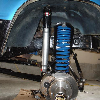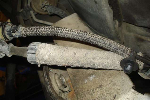@Fix4Dirt - I used my mechanics stethoscope to (attempt!) to figure out my noises, which are as follows:
Valve Ticking
100% sure it's valve ticking (not chain clattering); ticking directly at valve cover; only on passenger side; only one valve (tick frequency coincides with RPMs and there's no sequential ticking); can't tell exactly which cylinder; not the front cylinder; maybe the middle cylinder, maybe the rear cylinder; seems to be more toward the middle cylinder. My takeaway is that I have one valve ticking and it's the passenger side middle cylinder.
Startup Rattle
100% sure it's chain rattle; only on startup; last about 1-second or less; primarily on first-of-day start; haven't determined which chain/s is/are rattling on startup; maybe the front chain; maybe the rear chain; maybe both chains.
Chain Clattering
100% sure I don't have the "death clatter" (per video with good audio track); no clatter under load at 2000-3500 RPM; stethoscope conclusive for no clatter at front of engine; every-so-slight clatter (not rattle) at idle can be heard by listening underneath with ear and stethoscope; clatter frequency coincides with RPMs such that only one portion of the chain is clattering (not the entire chain for the entire time); cannot be heard by listening to engine with hood up (i.e., "above" or "at" engine); stethoscope on valve covers and tops of engine block inconclusive; stethoscope on bottoms of engine block (underneath) inconclusive; stethoscope on driver side header partially conclusive; stethoscope on passenger side header produces an ever-so-slight clatter; intense detailed listening on the passenger side header reveals an incredibly hard to discern two-tone sound that sounds like a chain clatter (not a one-tone sound such as the sound made by a ticking valve); discerning and discriminating these sounds is as much an art as it is a science. My takeaway is that the ever-so-slight clatter is coming from the rear chain.
My Approach
In the beginning, I was solely focused on the ticking valve. Why? Because I could easily hear it with my ear
and I didn't hear any other noises (because I never went underneath to listen). HOWEVER, after listening underneath, I changed my focus. Only after listening underneath did I learn about the chain clatter. Thus, my takeaway is that I have three noises: (1) startup rattle, (2) a single valve ticking, and (3) a every-so-slight clatter in the rear chain.










